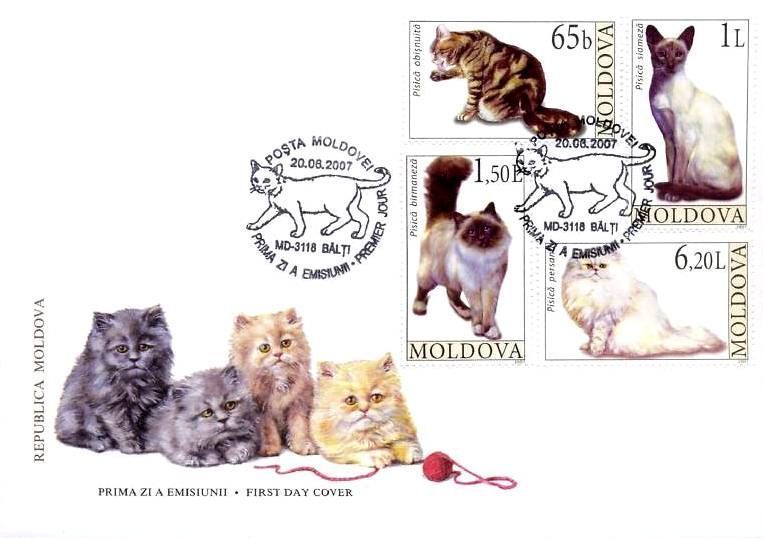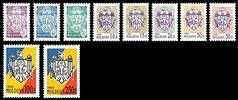POSTAGE STAMPS
|
|
Ordinary Cat
- Michel Catalogue No: 586
- Perforation Type/Size: Comb 14:14.50
- Size: 46.00 x 27.50 mm
- Face Value: 0.65 Lei
- Quantity Printed: 150,000
|
|
| |
|
Siamese Cat
- Michel Catalogue No: 587
- Perforation Type/Size: Comb 14.50:14
- Size: 27.50 x 46.00 mm
- Face Value: 1 Lei
- Quantity Printed: 200,000
|
The Siamese (Thai: วิเชียรมาศ, RTGS: Wichianmat, meaning 'moon diamond') is one of the first distinctly recognized breeds of Oriental cat. One of several breeds native to Thailand (formerly known as Siam), in the 20th century the Siamese cat became one of the most popular breeds in Europe and North America. The modern Siamese is characterized by blue almond-shaped eyes, a triangular head shape, large ears, an elongated, slender, and muscular body, and point coloration. TICA describes the breed as social, intelligent, and playful into adulthood, often enjoying a game of fetch. Siamese prefer to live in pairs or groups and also seek human interaction. Their Meezer nickname refers to their vocal nature. The Oriental cat was developed in order to expand the range of coat patterns while the Thai preserves a moderate head and body type. Read more..
This article uses material from the Wikipedia article 'Siamese_%28cat%29', which is released under the Creative Commons Attribution-Share-Alike License 3.0. |
| |
|
Burmese Cat
- Michel Catalogue No: 588
- Perforation Type/Size: Comb 14.50:14
- Size: 27.50 x 46.00 mm
- Face Value: 1.5 Lei
- Quantity Printed: 100,000
|
The Burmese (Thai: ศุภลักษณ์ RTGS: Suphalak meaning fortunate, beautiful, and splendid appearance) is a breed of domesticated cats split into two subgroups: the American Burmese and the British Burmese (and are not to be confused with 'Sacred Cat of Burma,' in respect of which, see Birman). Most modern Burmese are descendants of one female cat called Wong Mau, which was brought from Burma to America in 1930. Most cat registries do not recognize a split between the two groups, but those that do formally refer to the type developed by British cat breeders as the European Burmese. Read more..
This article uses material from the Wikipedia article 'Burmese_%28cat%29', which is released under the Creative Commons Attribution-Share-Alike License 3.0. |
| |
|
Persian Cat
- Michel Catalogue No: 589
- Perforation Type/Size: Comb 14:14.50
- Size: 46.00 x 27.50 mm
- Face Value: 6.2 Lei
- Quantity Printed: 50,000
|
|
| |







